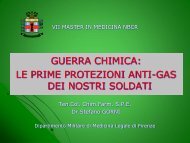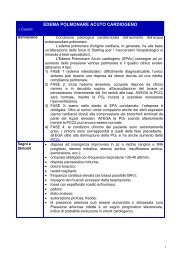(Microsoft PowerPoint - Carbonchio.ppt [modalit\340 ... - E-learning
(Microsoft PowerPoint - Carbonchio.ppt [modalit\340 ... - E-learning
(Microsoft PowerPoint - Carbonchio.ppt [modalit\340 ... - E-learning
You also want an ePaper? Increase the reach of your titles
YUMPU automatically turns print PDFs into web optimized ePapers that Google loves.
Master in Medicina NBC - 2011<br />
<strong>Carbonchio</strong><br />
Prof. Prof. Pasquale Pasquale Pasquale Urbano<br />
Urbano<br />
Collegamento al Consensus e alle linee guida europee<br />
Le microfotografie originali<br />
di Robert Koch, sul bacillo<br />
del carbonchio<br />
P. Urbano per il Master in Medicina NBC – 2011<br />
Vaccino anticarbonchioso<br />
Il vaccino disponibile per uso umano è poco<br />
efficace<br />
PaxVax Inc. of San Diego will develop and test two formulations of an<br />
anthrax vaccine. Both formulations contain a gene known as rPA, which<br />
codes for a protein that protected animals from anthrax in previous<br />
studies. The gene will be inserted into a carrier virus or vector called<br />
adenovirus 4 and the vaccine delivered orally via a capsule. The<br />
adenovirus 4 vector is a modified live-virus vaccine that has been<br />
studied for more than 40 years and has a good safety profile in<br />
humans. Pending review and approval of the Investigational New Drug<br />
Application by the Food and Drug Administration, a Phase 1 clinical<br />
trial will be conducted to select one of the two formulations for<br />
further development. NIAID has made an initial award of $3.8 million<br />
to PaxVax. If milestones are met, the total award could amount to<br />
$23.8 million over the next nine years.<br />
http://www.dddmag.com/news-NIH-Funding-Bioterror-Vaccines-10810.aspx<br />
P. Urbano per il Master in Medicina NBC – 2011<br />
<strong>Carbonchio</strong><br />
Non è una cosa nuova, e in italiano<br />
si è sempre chiamato così<br />
È sbagliato chiamarlo ‘antrace’,<br />
come fanno i media e come,<br />
deplorevolmente, sta entrando<br />
nell’uso<br />
I vecchi testi lo trattano<br />
estesamente<br />
P. Urbano per il Master in Medicina NBC – 2011<br />
Vaccino anticarbonchioso<br />
Storicamente, il carbonchio è la<br />
prima malattia per prevenire la<br />
quale fu dimostrato efficace un<br />
vaccino batterico<br />
Le colture attenuate ottenute da<br />
Pasteur dimostrarono la loro<br />
efficacia immunizzante nel famoso<br />
esperimento di Pouilly Le Fort nel<br />
1881.<br />
P. Urbano per il Master in Medicina NBC – 2011<br />
Vaccino anticarbonchioso<br />
Emergent Biosolutions of Rockville, Md., also will develop<br />
and test an anthrax vaccine. The candidate vaccine<br />
consists of Emergent's licensed anthrax vaccine<br />
(BioThrax) combined with an adjuvant. The investigational<br />
vaccine was tested in a Phase 1 clinical trial prior to the<br />
award of this contract. This new award will fund<br />
manufacturing, stability studies, assay validation and<br />
clinical trial preparation of the vaccine product. After<br />
those activities are completed, the vaccine may begin<br />
Phase 2 clinical testing. Emergent has received an initial<br />
award of $9.1 million, with the potential for total funding<br />
of up to $28.7 million over the next four years if clinical<br />
milestones are met.<br />
http://www.dddmag.com/news-NIH-Funding-Bioterror-Vaccines-10810.aspx<br />
P. Urbano per il Master in Medicina NBC – 2011<br />
1
Diagnosi sulle carogne<br />
Termoprecipitazione di Ascoli<br />
[1911]<br />
Estratti a caldo, filtrati, vengono<br />
stratificati in una provetta sottile<br />
contenente siero anticarbonchioso<br />
La formazione di un anello di<br />
precipitato è diagnostica<br />
Importante presidio di<br />
profilassi generale<br />
P. Urbano per il Master in Medicina NBC – 2011<br />
<strong>Carbonchio</strong> in Italia - 2011<br />
At the moment there are 39 suspected<br />
animals in Campania region (9<br />
confirmed); and 14 in Basilicata.<br />
V. nota<br />
<strong>Carbonchio</strong><br />
Agente: Bacillus<br />
anthracis<br />
Spore e tossine<br />
Forme cutanee,<br />
inalatorie** **,<br />
intestinali<br />
P. Urbano per il Master in Medicina NBC – 2011<br />
**Sospettare il bioterrorismo<br />
<strong>Carbonchio</strong> P. Urbano per il Master in Medicina NBC – 2011<br />
P. Urbano per il Master in Medicina NBC – 2011<br />
Forma vegetativa di B. anthracis, da<br />
coltura. Gram<br />
P. Urbano per il Master in Medicina NBC – 2011<br />
Bacillus anthracis, SEM colorata<br />
P. Urbano per il Master in Medicina NBC – 2011<br />
2
P. Urbano per il Master in Medicina NBC – 2011<br />
Genetica<br />
La virulenza dipende<br />
dalla capsula,<br />
governata dal<br />
plasmide pXO2<br />
La patogenicità dipende<br />
da LF e EF, che si<br />
associano a PA a<br />
formare le esotossine,<br />
governate dal plasmide<br />
pXO1<br />
Tossine del <strong>Carbonchio</strong><br />
I componenti della tossina sono tre:<br />
• OF [Oedema Factor]<br />
• LF [Lethal Factor]<br />
• PA [Protective Antigen]<br />
Agiscono di concerto; isolatamente,<br />
non sono tossici<br />
P. Urbano per il Master in Medicina NBC – 2011<br />
PA del <strong>Carbonchio</strong><br />
E’ la componente deputata a riconoscere<br />
il recettore, l’ATR [Anthrax Toxin<br />
Receptor], una proteina di membrana di<br />
tipo I, che ha un dominio extracellulare<br />
A del Fattore di von Willebrand.<br />
Legata al recettore, PA viene clivato in<br />
una parte che si perde e in un<br />
frammento carbossiterminale che<br />
eptamerizza, acquisendo affinità per OF<br />
e/o LF, che possono così essere<br />
endocitati e agire nel citosol.<br />
P. Urbano per il Master in Medicina NBC – 2011<br />
Capsula<br />
Polimero di acido D-gammaglutammico,<br />
formato da CapD, una<br />
transpeptidasi codificata nel plasmide<br />
pXO2<br />
Costituisce il principale fattore di<br />
virulenza, non trovando recettori sui<br />
macrofagi<br />
P. Urbano per il Master in Medicina NBC – 2011<br />
B. anthracis,<br />
geni per le<br />
tossine<br />
P. Urbano per il Master in Medicina NBC – 2011<br />
Intossicazione da B. anthracis<br />
P. Urbano per il Master in Medicina NBC – 2011<br />
3
Fattore Edemigeno (EF) del<br />
carbonchio<br />
• 89 kDa<br />
Gene su plasmide pXO1<br />
adenilato ciclasi calcio- e<br />
calmodulina-dipendente, che porta<br />
alla formazione di edema e<br />
all’inibizione delle funzioni dei<br />
polimorfonucleati<br />
P. Urbano per il Master in Medicina NBC – 2011<br />
Fattore Letale (LF) del <strong>Carbonchio</strong><br />
•90 kDa, gene sul plasmide pXO1<br />
•LF è una zinco-endoproteasi che taglia<br />
l’aminotermine delle protein-chinasi<br />
mitogeno attivate 1 e 2 (MAPK K1 e K2),<br />
inattivandole, e così bloccando la<br />
trasduzione del segnale di attivazione<br />
Nei macrofagi:<br />
attivazione del burst ossidativo rilascio<br />
di ossigeno reattivo<br />
induzione di citochine proinfiammatorie,<br />
quali TNF e IL-1ß shock e morte<br />
P. Urbano per il Master in Medicina NBC – 2011<br />
P. Urbano per il Master in Medicina NBC – 2011 P. Urbano per il Master in Medicina NBC – 2011<br />
Spora del carbonchio e macrofago<br />
P. Urbano per il Master in Medicina NBC – 2011<br />
<strong>Carbonchio</strong> Cutaneo<br />
Incubazione 1-12 gg<br />
Papula -> vescicola o ulcera -> escara<br />
centrale nera con alone rosso vivo, per<br />
diversi giorni<br />
Diagnosi: Batterioscopia (Gram) e<br />
coltura da vescicole, base dell’ulcera,<br />
sotto il margine dell’escara<br />
Buona risposta al trattamento<br />
P. Urbano per il Master in Medicina NBC – 2011<br />
4
<strong>Carbonchio</strong> Cutaneo<br />
P. Urbano per il Master in Medicina NBC – 2011<br />
<strong>Carbonchio</strong> cutaneo<br />
Realistico moulage in<br />
cera, nel museo al<br />
Chiostro del Maglio<br />
P. Urbano per il Master in Medicina NBC – 2011<br />
P. Urbano per il Master in Medicina NBC – 2011 P. Urbano per il Master in Medicina NBC – 2011<br />
<strong>Carbonchio</strong> da inoculazione<br />
•È in corso un’epidemia fra gli<br />
eroinomani, in Scozia, UK e in<br />
Germania<br />
•Contaminazione con spore di<br />
eroina proveniente<br />
dall’Afganistan<br />
•35 casi, 11 morti, al 22 aprile<br />
2010<br />
P. Urbano per il Master in Medicina NBC – 2011<br />
Epidemia di<br />
carbonchio cutaneo<br />
Nella prima guerra mondiale l’esercito<br />
inglese fu colpita da una vasta epidemia di<br />
carbonchio cutaneo, a localizzazione sul<br />
viso e allo scalpo, per l’impiego di spazzole<br />
e pennelli da barba prodotti in India con<br />
setole contaminate da spore carbonchiose<br />
<strong>Carbonchio</strong> da inoculazione<br />
•È stata ventilata e discussa una possibile causa<br />
dolosa, bioterroristica, della contaminazione<br />
con spore carbonchiose dell’eroina grezza che<br />
sta causando l’epidemia in Scozia e Inghilterra<br />
•È considerata plausibile, ma improbabile e<br />
praticamente non provabile<br />
•Vedi nota<br />
P. Urbano per il Master in Medicina NBC – 2011<br />
5
<strong>Carbonchio</strong> da inoculazione<br />
Su Lancet, Vol 375 April 17, 2010, p. 1345 è<br />
presentato il quadro clinico di questa nuova<br />
forma di carbonchio.<br />
Estratto in:<br />
http://download.thelancet.com/pdfs/journ<br />
als/lancet/PIIS0140673610605739.pdf?id<br />
=3d35b1b5aa0ec416:-<br />
47766f9:12824058b61:683912719201079<br />
87<br />
P. Urbano per il Master in Medicina NBC – 2011<br />
Resistenza spore<br />
Le spore resistono per tempi lunghissimi,<br />
indefiniti, agli agenti naturali di<br />
disinfezione<br />
Spore carbonchiose reperite negli intonaci<br />
dei più vecchi tronchi della metropolitana<br />
londinese<br />
Spore ancora attive dopo 48 anni, nell’isola<br />
di Gruinard contaminata per provare la<br />
dispersione con testate di artiglieria<br />
Rischio per scavi attraverso sito sepolcrale<br />
del 16 secolo vedi nota<br />
P. Urbano per il Master in Medicina NBC – 2011<br />
Gruinard Island<br />
Nel 1942, utilizzata per esperimenti di guerra biologica<br />
con spore carbonchiose.<br />
Scelta per la lontananza da luoghi molto popolati;<br />
confiscata ai pochi abitanti, poi risarciti, l’isola è servita<br />
per provare le modalità di dispersione di spore caricate<br />
su ordigni esplosivi.<br />
Il successo delle prove è stato dimostrato dalla moria<br />
del bestiame ripetutamente portato a pascolare<br />
sull’isola. [Interdizione di area]<br />
L’isola risultava ancora contaminata negli anni ‘80.<br />
Nell’86 grossa operazione dei decontaminazione<br />
280 tonnellate di formaldeide in acqua di mare spruzzata sui<br />
196 ettari di superficie buon esito e fine della quarantena<br />
P. Urbano per il Master in Medicina NBC – 2011<br />
PROCEDURE OPERATIVE<br />
PER LA GESTIONE DI<br />
MATERIALE<br />
POTENZIALMENTE<br />
CONTAMINATO DA<br />
Bacillus anthracis<br />
P. Urbano per il Master in Medicina NBC – 2011<br />
BBC, 18 marzo 2010<br />
P. Urbano per il Master in Medicina NBC – 2011<br />
Operation Dark Harvest<br />
In 1981 British newspapers began receiving messages with the<br />
heading "Operation Dark Harvest" which demanded that the<br />
government decontaminate the island, and reported that a "team<br />
of microbiologists from two universities" had landed on the island<br />
with the aid of local people and collected 300 lbs of soil. The<br />
group threatened to leave samples of the soil "at appropriate<br />
points that will ensure the rapid loss of indifference of the<br />
government and the equally rapid education of the general public".<br />
The same day a sealed package of soil was left outside the<br />
military research facility at Porton Down; tests revealed that it<br />
contained anthrax bacilli. A few days later another sealed<br />
package of soil was left in Blackpool, where the ruling<br />
Conservative Party was holding its annual conference. The soil did<br />
not contain anthrax, but officials said that the soil was similar to<br />
that found on the island. [10]<br />
Bioterrorismo bello e buono !<br />
P. Urbano per il Master in Medicina NBC – 2011<br />
6
P. Urbano per il Master in Medicina NBC – 2011 P. Urbano per il Master in Medicina NBC – 2011<br />
La forma clinica che si teme a<br />
seguito di un attacco massiccio,<br />
per aerosolizzazione delle spore<br />
carbonchiose, è il<br />
<strong>Carbonchio</strong> da inalazione<br />
P. Urbano per il Master in Medicina NBC – 2011<br />
Decontaminazione - cautele<br />
Per agire in zone contaminate da<br />
agenti biologici occorrono<br />
cautele particolari<br />
Presidi personali di protezione<br />
Vestizione<br />
Lavaggio<br />
Svestizione<br />
P. Urbano per il Master in Medicina NBC – 2011<br />
P. Urbano per il Master in Medicina NBC – 2011 P. Urbano per il Master in Medicina NBC – 2011<br />
7
P. Urbano per il Master in Medicina NBC – 2011 P. Urbano per il Master in Medicina NBC – 2011<br />
P. Urbano per il Master in Medicina NBC – 2011 P. Urbano per il Master in Medicina NBC – 2011<br />
P. Urbano per il Master in Medicina NBC – 2011 P. Urbano per il Master in Medicina NBC – 2011<br />
8
P. Urbano per il Master in Medicina NBC – 2011 P. Urbano per il Master in Medicina NBC – 2011<br />
P. Urbano per il Master in Medicina NBC – 2011 P. Urbano per il Master in Medicina NBC – 2011<br />
Nature. 2001 Nov 8;414(6860):225-9.<br />
Identification of the cellular receptor for anthrax toxin.<br />
Bradley KA, Mogridge J, Mourez M, Collier RJ, Young JA.<br />
The tripartite toxin secreted by Bacillus anthracis, the<br />
causative agent of anthrax, helps the bacterium evade the<br />
immune system and can kill the host during a systemic<br />
infection. Two components of the toxin enzymatically<br />
modify substrates within the cytosol of mammalian cells:<br />
oedema factor (OF) is an adenylate cyclase that impairs<br />
host defences through a variety of mechanisms including<br />
inhibiting phagocytosis; lethal factor (LF) is a zincdependent<br />
protease that cleaves mitogen-activated protein<br />
kinase kinase and causes lysis of macrophages. Protective<br />
antigen (PA), the third component, binds to a cellular<br />
receptor and mediates delivery of the enzymatic<br />
components to the cytosol. Here we describe the cloning of<br />
the human PA receptor using a genetic complementation<br />
approach. The receptor, termed ATR (anthrax toxin<br />
receptor), is a type I membrane protein with an<br />
extracellular von Willebrand factor A domain that binds<br />
directly to PA. In addition, a soluble version of this domain<br />
can protect cells from P. Urbano the per il action Master in of Medicina the NBC toxin. – 2011<br />
Sensor To Detect Agents Used<br />
In Biological Warfare<br />
Researchers from the University at Buffalo are developing a handheld sensor<br />
that can detect the presence of toxins potentially used as agents in biological<br />
warfare.<br />
The proposed sensor, which will utilize opticaldetection<br />
and chemical-sensing technologies, could be<br />
used in urban, military, industrial and even home<br />
environments,<br />
The sensor will be composed of three<br />
components -- a LED (light emitting diode), a<br />
xerogel-based sensor array and a CMOS<br />
(complementary metal-oxide semiconductor)<br />
detector, commonly used in miniature digital<br />
cameras.<br />
P. Urbano per il Master in Medicina NBC – 2011<br />
9
The test uses a fluorescent 'substrate' to<br />
indicate the activity of lethal factor<br />
protease. Two fluorescent probes are<br />
attached to a synthesized target—a small<br />
peptide that looks like proteins cleaved by<br />
lethal factor in human cells. The cutting of<br />
the target molecule produces a fluorescent<br />
glow.<br />
Proceedings of the National Academy of<br />
Sciences<br />
P. Urbano per il Master in Medicina NBC – 2011<br />
Avanzamento conoscenze<br />
Recenti indagini hanno<br />
chiarito le tappe della<br />
sporogenesi e identificato le<br />
circa 750 proteine che si<br />
ritrovano nelle spore<br />
P. Urbano per il Master in Medicina NBC – 2011<br />
Spora di B<br />
anthracis, 92,000x<br />
•L’Istituto per la Ricerca Genomica (TIGR) di Rockville,<br />
Md, ha sequenziato l’intero genoma del B. anthracis, e ha<br />
poi creato una micromatrice che lo rappresenta tutto, per<br />
indagare l’attivazione sequenziale dei geni durante la<br />
sporogenesi.<br />
"MASTER SWITCH." Another<br />
microbial enzyme, known as DNA<br />
adenine methylase (DAM), is the target<br />
of Remedyne Corp., a startup founded<br />
by scientists at the University of<br />
California, Santa Barbara. The<br />
researchers discovered that DAM is a<br />
"master switch" that controls more<br />
than 20 genes that are critical to many<br />
bacteria's ability to infect their hosts.<br />
When they engineered bacteria with a<br />
defective form of DAM, the virulent<br />
bugs turned into pussycats: They<br />
survived -- but they couldn't cause<br />
disease.<br />
P. Urbano per il Master in Medicina NBC – 2011<br />
Nature. 2001 Nov 8;414(6860):229-33.<br />
Crystal structure of the anthrax lethal factor.<br />
Pannifer AD, Wong TY, Schwarzenbacher R, Renatus M, Petosa C, Bienkowska J,<br />
Lacy DB, Collier RJ, Park S, Leppla SH, Hanna P, Liddington RC.<br />
Lethal factor (LF) is critical in the pathogenesis of anthrax. It<br />
is a highly specific protease that cleaves members of the<br />
mitogen-activated protein kinase kinase (MAPKK) family<br />
near to their amino termini, leading to the inhibition of one<br />
or more signalling pathways. LF comprises four domains:<br />
domain I binds the membrane-translocating component of<br />
anthrax toxin, the protective antigen (PA); domains II, III<br />
and IV together create a long deep groove that holds the<br />
16-residue N-terminal tail of MAPKK-2 before cleavage.<br />
Domain II resembles the ADP-ribosylating toxin from<br />
Bacillus cereus, but the active site has been mutated and<br />
recruited to augment substrate recognition. Domain III is<br />
inserted into domain II, and seems to have arisen from a<br />
repeated duplication of a structural element of domain II.<br />
Domain IV is distantly related to the zinc metalloprotease<br />
family, and contains the catalytic centre; it also resembles<br />
domain I. The structure thus reveals a protein that has<br />
evolved through a process of gene duplication, mutation and<br />
fusion, into an enzyme with high and unusual specificity.<br />
P. Urbano per il Master in Medicina NBC – 2011<br />
Avanzamento delle<br />
conoscenze<br />
To detect the presence of the toxins, the researchers<br />
will produce sensors called Protein Imprinted Xerogel<br />
with Integrated Emission Sites (PIXIES). Within the<br />
PIXIES, a tiny fluorescent dye molecule is placed within<br />
the xerogel's imprint sight. The PIXIES then are placed<br />
atop the LED, which is used to stimulate the fluorescent<br />
dye to emit light.<br />
The fluorescent molecule is sensitive to the presence of<br />
other molecules in its immediate environment. Thus, when<br />
the target toxin is recognized by the PIXIES, the<br />
fluorescent molecule will change its light intensity<br />
P. Urbano per il Master in Medicina NBC – 2011<br />
Darrell Galloway, a microbiologist at Ohio State<br />
University, and colleagues at the National Institutes<br />
of Health and the Naval Medical Research Center,<br />
isolated the DNA from three genes that work in<br />
concert to create the deadly cascade of toxins<br />
secreted by anthrax bacteria. Using viral carriers,<br />
called plasmids, they incorporated these genetic<br />
snippets into the cells of healthy mice.<br />
When the treated mice were injected with five times<br />
the lethal dose of the anthrax bacterial toxin, those<br />
that received the plasmid injections were immune.<br />
Every animal in the control group died within hours.<br />
Moreover, the Ohio State team, in collaboration with<br />
scientists from researcher Battelle Group, have shown<br />
that the vaccine protects against aerosol-delivered<br />
anthrax -- the most deadly form -- more than a year<br />
later.<br />
P. Urbano per il Master in Medicina NBC – 2011<br />
10
Antibodies are the key to a third strategy being<br />
developed by EluSys that sops up microorganisms<br />
or toxins and ferries them out of the body. The<br />
tricky molecules, which the company calls<br />
Heteropolymer (HP) technology, consist of two<br />
antibodies that are chemically bound together.<br />
One attaches the molecule to a red blood cell,<br />
the other is designed to bind to the biowar agent,<br />
such as the anthrax toxin. The immobilized<br />
biowar agents then get a ride on the red blood<br />
cells to the liver, where they are destroyed. "It's<br />
like two-sided sticky tape," explains George L.<br />
Spitalny, the company's vice-president for R&D.<br />
P. Urbano per il Master in Medicina NBC – 2011<br />
<strong>Carbonchio</strong><br />
Anthrax FAQ, 2005<br />
Anthrax as a Biological Weapon, 2002: Updated Recommendations for<br />
Management<br />
[JAMA 287(17),2002]<br />
Anthrax as a Biological Weapon: Medical & Public Health Management<br />
(1999)<br />
[JAMA 281(18),1999]<br />
Anthrax Fact Sheet, 2002<br />
Anthrax Fact Sheet, 1999<br />
Anthrax Bibliography<br />
Considering Anthrax Vaccine for Post- Exposure Prophylaxis<br />
Slides Presented at Meeting on Anthrax Vaccine, National Academy of<br />
Sciences, December 15, 2001<br />
Clinical Anthrax: Primer for Physicians<br />
Case Studies of Bioterrorism-Related Inhalational Anthrax<br />
FAQ: Environmental Detection of Anthrax<br />
P. Urbano per il Master in Medicina NBC – 2011<br />
Master in Medicina NBC - 2011<br />
Grazie dell’attenzione<br />
Domande?<br />
Domande?<br />
b<br />
e<br />
r<br />
3<br />
0<br />
,<br />
2<br />
0<br />
0<br />
1<br />
a<br />
n<br />
d<br />
n<br />
u<br />
m<br />
b<br />
e<br />
r<br />
o<br />
f<br />
Falsi allarmi dopo veri casi<br />
EID, Volume 9, Number 4, April 2003<br />
P. Urbano per il Master in Medicina NBC – 2011<br />
ROC per <strong>Carbonchio</strong><br />
EID, Volume 10, Number 1, January 2004<br />
P. Urbano per il Master in Medicina NBC – 2011<br />
11



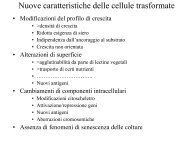


![lezione incontinenza Prof. Nicita.ppt [Sola lettura] - E-learning ...](https://img.yumpu.com/49370218/1/184x260/lezione-incontinenza-prof-nicitappt-sola-lettura-e-learning-.jpg?quality=85)





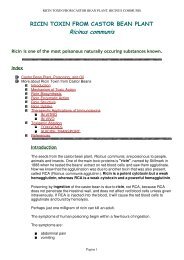
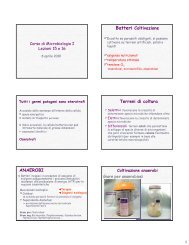
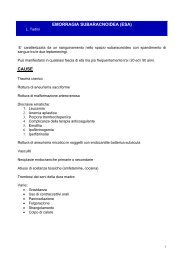
![ipertrofia prostatica benigna.PPT [Sola lettura] - E-learning](https://img.yumpu.com/33829773/1/184x260/ipertrofia-prostatica-benignappt-sola-lettura-e-learning.jpg?quality=85)
